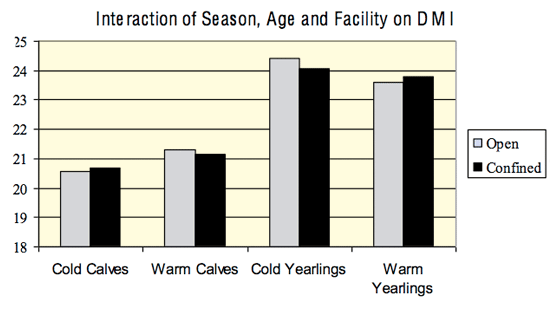



Fed Cattle Performance In Open Lots & Bedded Confinements
Jeff Pastoor, graduate student at Iowa State University and Dan Loy, Professor of Animal Science at IOwa compare cattle performance of cattle fed in open lots compared to cattle fed in bedded confinement buildings.Summary and Implications
Fed cattle closeouts from the years 2007-2009 were analyzed to measure the difference in performance of cattle fed in open lots compared to cattle fed in bedded confinement buildings. Cattle fed in bedded confinements had better feed conversions and heavier finish weights then cattle fed in open lots. Cattle fed in bedded confinements also tended to have better daily gains then cattle fed in open lots.
Introduction
There has been renewed interest in confining fed beef cattle under roof while on feed. This has come about from two primary concerns; the desire to better control manure for environmental compliance and manure nutrient retention, and severe summer and winter weather that has negatively effected cattle performance and costs of gain. Many new cattle confinements have been built in the last 10 years; most of these have been solid floor bedded confinement buildings of a monoslope or hoop roof design. Previous data and conventional wisdom indicated that cattle performance should be better in the bedded confinement buildings. The purpose of this study was to compare the performance of cattle fed in open lots with those fed in bedded confinement buildings.
Materials and Methods
Closeout records from the Land O’Lakes Feedlot Performance and Cost Monitoring program are kept in a database, and were used in this study to compare the closeout results of open lots and bedded confinements. The Land O’Lakes Beef Specialists and Beef Consultants were surveyed to determine the housing type associated with each of the closeouts. Pens defined as open lots were primarily earthen lots without access to shelter. Bedded confinements were buildings where cattle were kept in confinement under roof on a bedding pack; these would include hoop buildings, wide monoslope (feedbunks on two sides) and narrow monoslope (feedbunk on one side) roofed buildings. Records were analyzed from cattle that were closed out between January 1, 2007 and December 31, 2009. A total of 990 closeouts were analyzed.
Data analyzed as main effects were sex, age, year, season, and facility type. Age of the cattle were assigned by start weight; steers less then 700 pounds and heifers less then 650 pounds start weight were presumed to be calves for these data; cattle over those weights were presumed to be yearlings. Seasons were defined as winter fed cattle (those closed out between January 1 and June 30, COLD) and summer fed cattle (those closed out between July 1 and December 31, WARM). Data analyzed as variables were average daily gain (ADG) defined as pen weight gain divided by head days in the pen, feed dry matter intake per unit of ADG (F/G), average daily dry matter intake (DMI), days on feed calculated as the weighted average time each steer in the pen was on feed (DOF), initial payweight, final payweight, weighted average NEg of the diet as delivered expressed as Mcal per 100 lb. of dry matter (NEg), and death loss expressed as a percent of the number of cattle purchased. Since all of these closeouts came from feedlots that were working with Land O’Lakes Beef Specialists or Consultants, it was assumed that rations were balanced properly for protein, minerals, and ionophore levels. NEg of the diets were analyzed to check for this variable as a source of variation. Records with death loss greater then four Standard Deviations from the mean were removed as outliers. The data were analyzed using the Mixed Procedure of SAS.
Results and Discussion
Performance by facility type is reported in Table 1. While initial weights were not significantly different, the final weights were significantly improved by feeding in the bedded confinements (CONF). F/G was significantly improved and there was a trend towards improving the ADG in the CONF compared to the open lots (OPEN). DOF and death loss showed non-significant but numeric improvements in CONF. DMI and the NEg were very similar across both facility types.
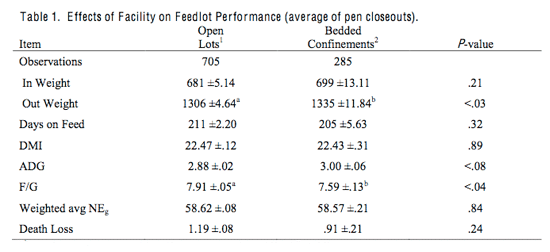
Interactions involving sex, age, and facility were studied; the significant interactions are presented in Figures 1-3. ADG was improved for steer calves, yearling steers and yearling heifers, but not for heifer calves. F/G was improved for steer and heifer calves and yearling steers and heifers, but the degree of improvement was minimal for the heifer calves. Finish weights were improved for all four groups. For the purpose of illustration, the death loss by sex, age, and facility is show in Figure 4. Though this interaction was not statistically significant, it is interesting to note that the heifer calves were the only group that saw a numeric increase in death loss in the bedded confinements. This may help explain why the heifer calves had no improvement in ADG and little improvement in F/G in the bedded confinement facilities.
Figure 1.
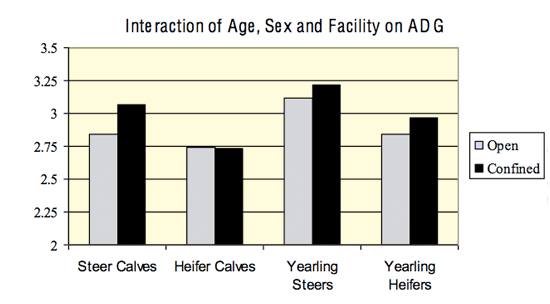
Figure 2.

Figure 3.

Interactions involving age, facility and season are presented in Figures 5-7. Calves and yearlings had improved ADG and F/G during both the COLD and WARM feeding seasons. Finish weights were improved by feeding in bedded confinements, but to a greater extent in the COLD vs WARM weather feeding seasons.
Figure 4.
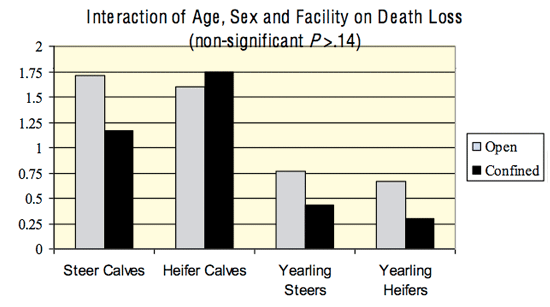
Figure 5.
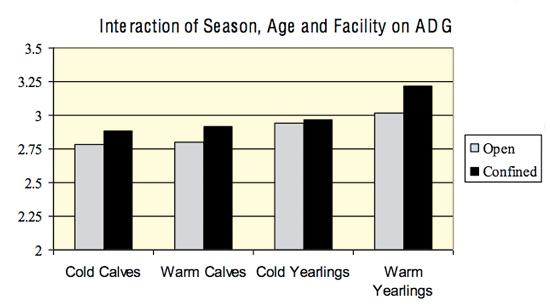
Figure 6.

An interesting interaction was observed with DMI as shown in Figure 8. Calves had slightly better DMI in the CONF during COLD weather, and slightly lower DMI in the CONF during the WARM season, compared to OPEN. Yearlings showed the opposite effect, with lower intakes in the CONF during the COLD season and higher intakes in the CONF during WARM season. Cattle fed in the CONF had better feed conversions and heavier finish weights then cattle fed in OPEN. Cattle fed in CONF also tended to have better daily gains then cattle fed in OPEN.
CONF also benefits the cattle feeder through improved manure nutrient management. Manure from bedded confinement buildings have been shown to be more consistent and captured in greater quantity then manure from open lots. Also, local water quality is improved by keeping rainwater away from the cattle manure under roof.
Figure 7.

Figure 8.
